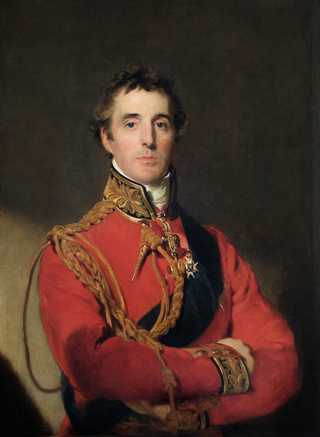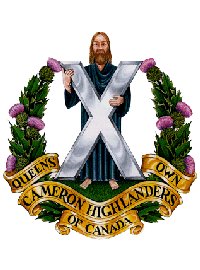
Field Marshal Arthur Wellesley, 1st Duke of Wellington, was an Anglo-Irish statesman, soldier, and British Tory politician who was one of the leading military and political figures of 19th-century Britain, serving twice as prime minister of the United Kingdom. He is among the commanders who won and ended the Napoleonic Wars when the Seventh Coalition defeated Napoleon at the Battle of Waterloo in 1815.

The Duke of Wellington's Regiment (West Riding) was a line infantry regiment of the British Army, forming part of the King's Division.

Private Henry James Tandey VC, DCM, MM was a British recipient of the Victoria Cross, the highest award for gallantry in the face of the enemy that can be awarded to British and Commonwealth forces. He was the second most highly decorated British private of the First World War and is most commonly remembered as the soldier who allegedly spared Adolf Hitler's life during the war. Born with the family name of Tandy, he later changed his surname to Tandey after problems with his father, and because of this, some military records have a different spelling of his name.

Captain John Hollington Grayburn VC was an English recipient of the Victoria Cross, the highest and most prestigious award for gallantry in the face of the enemy that can be awarded to British and Commonwealth forces.

Private Richard Henry Burton VC was an English recipient of the Victoria Cross, the highest and most prestigious award for gallantry in the face of the enemy that can be awarded to British and Commonwealth forces.

John Harrison was a professional rugby league footballer who played for Hull FC. He later became a British Army officer, and was the posthumous recipient of the Victoria Cross during the First World War, the highest and most prestigious award for gallantry in the face of the enemy that can be awarded to British and Commonwealth forces.

Major Henry Kelly VC, MC & Bar was an English recipient of the Victoria Cross, the highest and most prestigious award for gallantry in the face of the enemy that can be awarded to British and Commonwealth forces.

Arnold Loosemore was an English recipient of the Victoria Cross, the highest and most prestigious award for gallantry in the face of the enemy that can be awarded to British and Commonwealth forces.

Arthur Poulter was an English recipient of the Victoria Cross, the highest and most prestigious award for gallantry in the face of the enemy that can be awarded to British and Commonwealth forces.

Robert Edward Ryder VC was an English recipient of the Victoria Cross, the highest and most prestigious award for gallantry in the face of the enemy that can be awarded to British and Commonwealth forces.

The Queen's Own Cameron Highlanders of Canada is a Primary Reserve infantry regiment of the Canadian Army. It is part of the 3rd Canadian Division's 38 Canadian Brigade Group and is headquartered at the Minto Armoury in Winnipeg, Manitoba. It is the oldest highland regiment in Western Canada.

The Rajput Regiment is one of the oldest infantry regiments of the Indian Army, originating in 1778 with the raising of the 24th Regiment of Bengal Native Infantry. The 1st battalion of the regiment was formed in 1798.

The Green Howards Regimental Museum is the museum of the Green Howards infantry regiment of the British Army. It is located in the old Trinity Church in the centre of the market place of Richmond in the Richmondshire district of North Yorkshire, England. The Green Howards were amalgamated with The Prince of Wales's Own Regiment of Yorkshire and The Duke of Wellington's Regiment, all Yorkshire-based regiments in the King's Division, to form The Yorkshire Regiment on 6 June 2006.

Corporal Bryan James Budd, was a British Army soldier and a Northern Irish recipient of the Victoria Cross (VC), the highest award for gallantry in the face of the enemy that can be awarded to British and Commonwealth forces.

The Wellington Mounted Rifles Regiment was a mounted infantry regiment from New Zealand, raised for service during the First World War. It was assigned to the New Zealand Mounted Rifles Brigade, part of the New Zealand Expeditionary Force.

The Auckland Mounted Rifles Regiment was a mounted infantry regiment from New Zealand raised, in August 1914, for service during the First World War. It was assigned to the New Zealand Mounted Rifles Brigade, part of the New Zealand Expeditionary Force.
The Battle of Bau, or the Battle of Gunong Tepoi, was an engagement that occurred on 21 November 1965 in the border area of Sarawak in Borneo between British and Indonesian forces. It was part of the wider Indonesian–Malaysian confrontation, that consisted of a series of small-scale engagements involving Indonesia, Malaysia, the United Kingdom, Australia and New Zealand, and which took place over the course of 1962–1966. The engagement involved an attack by a 16-man advance squad of British Army Gurkhas on a company-sized Indonesian position. The Gurkhas were then supported by the 104 men in the rest of the company which resulted in the last Indonesians withdrawing after having virtually been destroyed. The Gurkha company, having suffered relatively light casualties but coming under increasing pressure from another Indonesian company nearby, retired from the position. As a result of the action, one Gurkha—Lance Corporal Rambahadur Limbu—received the Victoria Cross.

The Battle of Aidabasalala was a small but hard-fought action during the 1999 East Timorese crisis between pro-Indonesian militia and a six-man Australian covert reconnaissance patrol from the Special Air Service Regiment (SASR) operating as part of the United Nations-mandated International Force for East Timor (INTERFET). The battle took place near Aidabasalala, 15 kilometres (9.3 mi) from the West Timor border, and saw the Australians attacking a group of more than sixty armed militia. The SASR patrol had been detected whilst establishing an observation post over a village and had to fight their way to a landing zone, being attacked a further three times over a one-and-a-half-hour period, killing a number of their opponents before they were successfully extracted by S-70 Black Hawk helicopter.
Major Frederic Balfour Scott MC was a British Army officer who was awarded a Military Cross for gallantry whilst serving with the 2nd Battalion, The Oxfordshire and Buckinghamshire Light Infantry in Normandy during the Second World War.
Brigadier Ian Hamilton Burrows was a senior New Zealand Army officer. He served with the New Zealand Special Air Service in Malaya in 1955 as one of the "originals" before going on to senior command positions in the New Zealand Army, culminating in his promotion to brigadier and appointment as Commander of Land Forces New Zealand in 1981.















